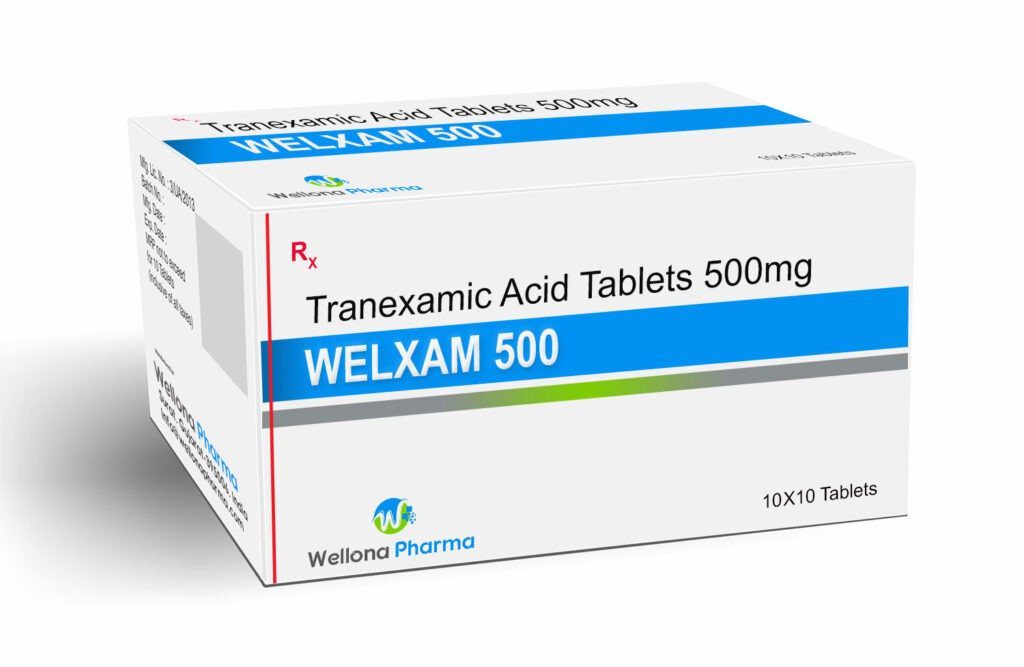Tranexamic acid has become a well-recognised treatment for managing heavy menstrual bleeding, offering an effective solution for many women. Heavy menstrual bleeding, also known as menorrhagia, can severely disrupt everyday life, from work commitments to social engagements. Women suffering from this condition often feel frustrated and fatigued due to the loss of blood, which can also lead to iron deficiency anaemia.
According to NHS guidance, tranexamic acid tablets can reduce menstrual blood loss by up to 50%, providing significant relief for those with menorrhagia. This medication, which has been prescribed for many years, is widely regarded as one of the most effective non-hormonal treatments for heavy menstrual bleeding. Its use is supported by numerous clinical trials, which demonstrate both its safety and efficacy. This makes it a reliable option for women seeking alternatives to hormonal treatments or invasive surgical procedures.
As awareness of its benefits continues to grow, it’s useful to understand how this medication works and whether it might be the right choice for you. In this article, we’ll cover everything you need to know about these tablets, including their uses, how they work, and guidance on their safe use and purchase.
Whether you’re new to the treatment or just looking for more information, this article aims to provide clear, helpful insights into this common medication.
What is Tranexamic Acid?

So, what is tranexamic acid? It is an antifibrinolytic medication, meaning it helps reduce bleeding by preventing the breakdown of blood clots in the body. Heavy menstrual bleeding, also known as menorrhagia, can be a debilitating condition for women, significantly impacting their daily activities and quality of life. For many women, the experience of menorrhagia can be overwhelming, particularly when it leads to restrictions on physical activity or social interaction.
This medication is commonly prescribed to women who experience heavy menstrual bleeding because it works by stabilising blood clots and reducing blood loss during periods. By preventing excessive bleeding, this product allows women to regain control over their daily lives, reducing the physical and emotional toll of dealing with prolonged or intense periods.
For those unfamiliar with the specifics, this product operates by inhibiting plasmin, an enzyme responsible for breaking down blood clots. By blocking this action, the medication allows the body to retain its clots longer, which, in turn, helps manage excessive bleeding. According to the NHS, tranexamic acid can reduce menstrual blood loss by up to 50%, making it a go-to option for many women dealing with heavy periods. This reduction in blood loss can lead to fewer symptoms of anaemia, such as fatigue, weakness, and dizziness, improving overall well-being and quality of life.
In addition to its use for heavy menstrual bleeding, tranexamic has other medical applications. It is often used to control bleeding during surgeries, dental procedures, and trauma. For instance, surgeons may administer tranexamic to reduce the risk of excessive blood loss during major operations such as heart surgery or knee replacements. Its effectiveness across various conditions highlights its versatility as a treatment. However, the focus of this article is its role in managing heavy periods, where it offers a practical, non-invasive solution for women who suffer from menorrhagia.
How Does Tranexamic Acid Work for Heavy Bleeding?
If you’re wondering what does tranexamic acid do, it works by reducing the breakdown of blood clots in the body, making it easier to control excessive bleeding. During menstruation, your body naturally forms clots to stop excessive blood loss.
However, in cases of menorrhagia, the clots may break down too quickly, leading to heavy and prolonged bleeding. This medication helps these clots remain intact by blocking an enzyme called plasmin, which dissolves clots. This results in reduced blood loss during periods and provides relief for women with menorrhagia.
The science behind this is relatively straightforward: when plasmin breaks down clots, it leads to a longer and heavier bleed. By inhibiting plasmin, tranexamic acid prevents this premature breakdown, allowing clots to stabilise and halt excessive bleeding. It’s worth noting that this medication doesn’t impact the overall menstrual cycle, nor does it alter hormone levels in the body, making it an appealing option for women who prefer non-hormonal solutions.
Clinical trials have demonstrated the effectiveness of tranexamic acid, with many women reporting a noticeable reduction in bleeding after just one or two cycles of use. Studies have also highlighted that the reduction in blood loss is significant enough to prevent iron deficiency anaemia, a common side effect of prolonged heavy bleeding. Additionally, women who use this report feeling less fatigued and more energised during their periods, as the reduction in blood loss improves their overall physical stamina.
The speed at which the medication works is another advantage, often starting to reduce bleeding within hours of the first dose. This quick action can be a lifesaver for women who experience sudden, unexpected heavy flows that may interfere with their daily responsibilities. Because it works rapidly, it provides not only physical relief but also peace of mind, knowing that an effective treatment is readily available.
What are the Ingredients in Tranexamic Acid Tablets?
The primary active ingredient in these tablets is, of course, tranexamic acid. This ingredient is responsible for preventing the breakdown of blood clots, helping to reduce heavy bleeding. Each tablet typically contains 500mg of tranexamic acid, although dosage may vary based on a doctor’s recommendation.
Beyond the active ingredient, the tablets contain several inactive ingredients, which help with the absorption of the medication. Common excipients include microcrystalline cellulose, which gives the tablet its shape, and magnesium stearate, which means that the ingredients mix properly and prevent clumping. These excipients play a major role in meaning that the medication is delivered effectively to the body.
It’s also essential to be aware of any potential allergens in the inactive ingredients. Although most women tolerate the tablets well, those with known allergies should review the full ingredient list before use. If you have concerns, your healthcare provider can offer guidance or suggest alternative treatments. Always make sure that you are not allergic to any of the components, especially if you have a history of allergies to medication. For example, individuals with sensitivities to certain food additives or preservatives should double-check the inactive ingredients for potential allergens.
Who Should Use Tranexamic Acid?
Tranexamic acid is primarily prescribed to women who experience heavy menstrual bleeding, also known as menorrhagia. It’s often recommended for those whose periods are so heavy that they impact daily life, causing discomfort or concern. Symptoms of menorrhagia include soaking through sanitary pads or tampons every hour, needing to change protection during the night, or experiencing periods lasting more than a week. These symptoms can cause significant disruption, limiting social and professional activities.
For many women, heavy periods also result in anaemia, which can lead to symptoms such as fatigue, shortness of breath, and dizziness. Tranexamic acid can help reduce these symptoms by controlling blood loss and maintaining healthier haemoglobin levels. By reducing the intensity and duration of periods, it allows women to carry on with their daily routines more comfortably.
Beyond menstrual bleeding, it can also be prescribed in specific situations, such as after childbirth or surgery, to help manage excessive bleeding. In the postpartum period, excessive bleeding can be life-threatening and is often used as part of a treatment plan to control this. NICE guidelines recommend tranexamic acid for women with heavy bleeding that disrupts their day-to-day activities. Additionally, women with conditions such as fibroids, which can cause heavy bleeding, may also benefit from this medication.
However, only some people are suitable for this medication. Women with clotting disorders, a history of thromboembolic events (such as deep vein thrombosis or stroke), or those taking blood thinners should avoid this treatment unless advised by a doctor. It’s also advised to consult a healthcare provider if you’re pregnant or breastfeeding as it may not be recommended in these situations. Your doctor will assess your medical history and any existing conditions to determine whether tranexamic acid is a safe and appropriate treatment for you.
How to Take Tranexamic Acid for Heavy Bleeding

Tranexamic acid is typically taken at the onset of your period when bleeding becomes heavy. The standard dosage is two tablets (usually 500 mg each) taken three times a day for up to four days. However, this can vary based on individual needs and a doctor’s recommendation. It’s crucial to follow your healthcare provider’s instructions to make sure that you are taking the medication correctly and at the appropriate time.
NHS guidance recommends taking this only during the heaviest flow days of your period to maximise its effectiveness and minimise side effects. Skipping doses or taking it on light-flow days may reduce its effectiveness, so adhering to a schedule is crucial. This precise timing can make a noticeable difference in the effectiveness of the treatment, meaning that heavy bleeding is reduced exactly when it is most needed.
While it is effective for many women, some may experience mild side effects, such as nausea, diarrhoea, or headaches. These side effects are usually mild and temporary, but there are ways to manage them if they occur. Staying well-hydrated, eating light meals, and resting when necessary can help alleviate these symptoms. If side effects persist or become bothersome, consult your doctor for advice.
It’s also strongly advised to be aware that tranexamic can interact with other medications. Women on anticoagulants or those with a history of thromboembolic conditions should discuss the use of this with their healthcare provider. Additionally, this medication should not be taken by women with kidney disease unless recommended and monitored by a doctor. Your doctor may suggest alternative treatments or monitor your kidney function closely if this medication is prescribed.
Benefits of Tranexamic Acid
Tranexamic acid is a highly effective treatment for reducing blood loss during periods, offering a significant improvement for women who experience heavy menstrual bleeding. According to the NHS, the key benefit of this treatment is its non-hormonal nature, making it an ideal choice for women who cannot or prefer not to use hormonal treatments, such as birth control pills or hormonal IUDs. This non-hormonal aspect is particularly appealing for women who wish to avoid hormone-related side effects such as mood swings, weight gain, or changes in libido.
Unlike hormonal treatments, tranexamic acid doesn’t affect the body’s hormone levels, which can be useful for those who prefer to avoid hormone-related side effects. Additionally, it has relatively few side effects compared to hormonal therapies, making it a more tolerable option for many women. Its cost-effectiveness and availability as a prescription medication in the UK also make it a practical solution for managing heavy periods.
Surgical options, such as endometrial ablation or hysterectomy, provide long-term relief from heavy bleeding but are more invasive and come with longer recovery times. Endometrial ablation is a procedure that destroys the lining of the uterus to reduce or stop bleeding, while a hysterectomy involves the removal of the uterus altogether, permanently ending menstruation. While these surgeries offer permanent solutions, they are not suitable for everyone, especially those who wish to have children in the future.
The non-hormonal, less invasive nature of tranexamic acid makes it a first-line treatment for many women. It provides flexibility in managing periods without the long-term commitments of hormonal treatments or surgery. This freedom from long-term side effects allows women to continue with their regular menstrual cycles without significant disruption or risk.
How to Buy Tranexamic Acid Tablets
In the UK, tranexamic acid is a prescription-only medication, meaning it must be obtained through a healthcare professional. You can access it by visiting your GP, a private clinic, or via licensed online pharmacies. The NHS advises that this medication should only be purchased from pharmacies that are registered with the General Pharmaceutical Council (GPhC) to avoid counterfeit medications, which can be unsafe.
When purchasing online, look for the GPhC logo and verify the pharmacy’s credentials before making a purchase. Following these precautions will help so that you receive genuine, safe medication for managing your heavy periods.
Tranexamic acid has proven to be a reliable, non-hormonal solution for women suffering from heavy menstrual bleeding. With its ability to reduce blood loss by up to 50%, it provides significant relief without the side effects associated with hormonal treatments.
Whether you’re managing heavy periods for the first time or seeking an alternative to more invasive options like surgery, tranexamic acid offers a safe and effective treatment backed by clinical evidence.
However, as with any medication, it’s essential to consult with a healthcare professional to make sure it’s the right choice for your needs. If heavy periods are affecting your quality of life, don’t wait any longer to explore your treatment options.
Speak to WePrescribe today to discuss how this treatment can help you regain control and improve your well-being. Take the first step toward relief from heavy bleeding now.


